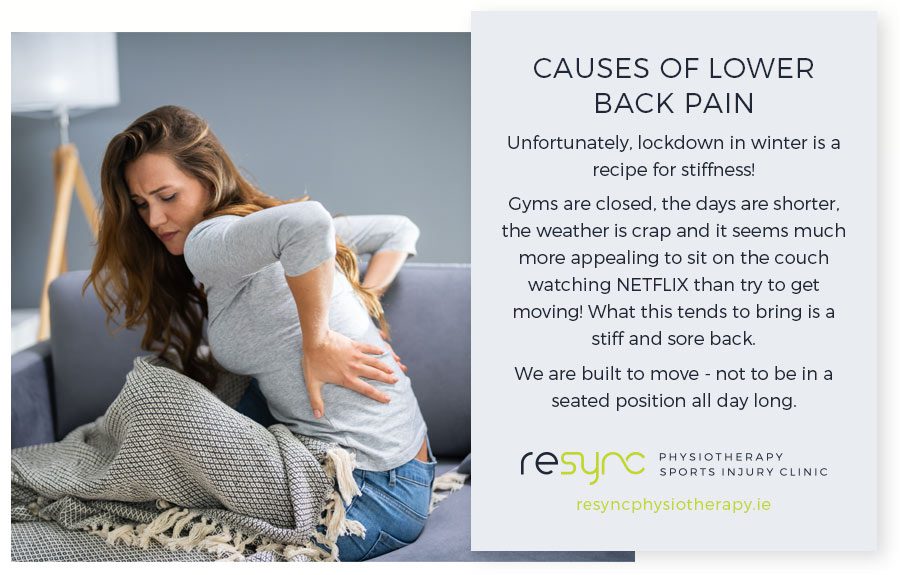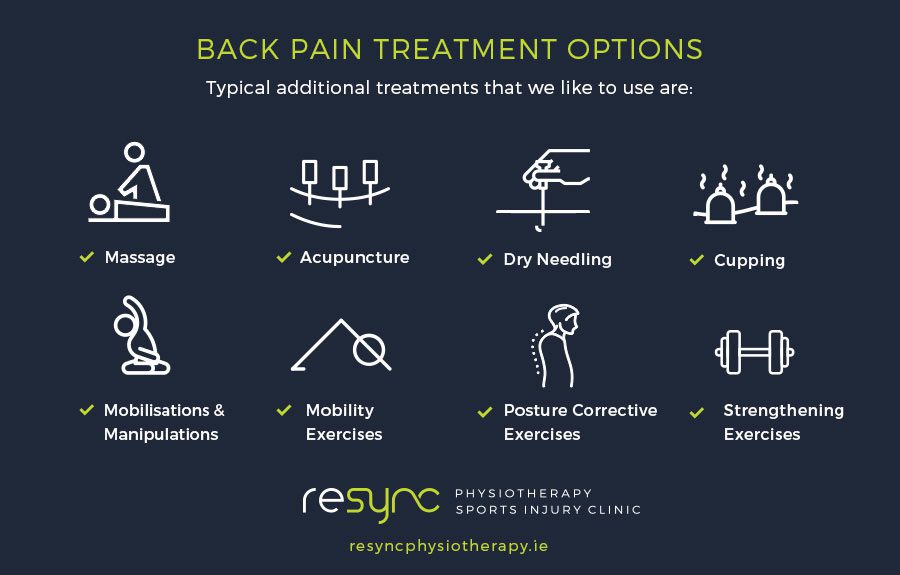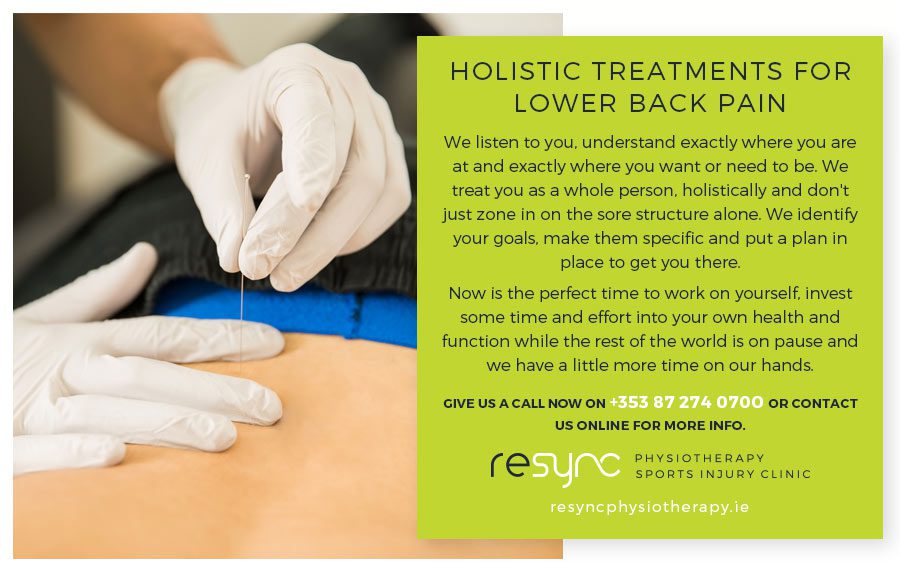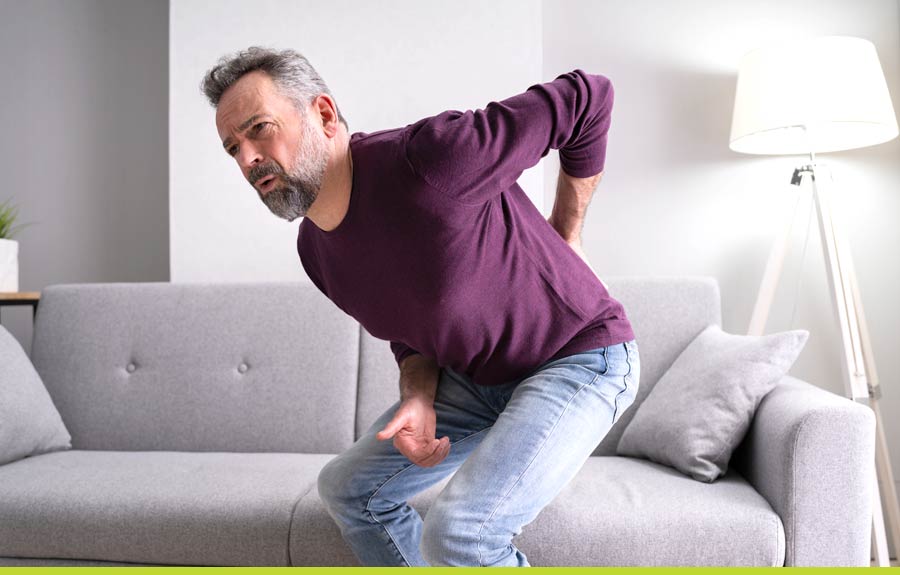Due to lockdown and working from home we are not moving as much as we used to. As a result we are seeing a huge surge in people contacting us with stiffness or pain in their neck, shoulders, upper backs and lower backs. If this sounds familiar – you might want to read on for some tips on how to minimise low back pain!
Causes of Lower Back Pain
Unfortunately, lockdown in winter is a recipe for stiffness! Gyms are closed, the days are shorter, the weather is crap and it seems much more appealing to sit on the couch watching Netflix than try to get moving! What this tends to bring is a stiff and sore back. We are built to move – not to be in a seated position all day long. Yes – sitting is inevitable for a huge part of our day especially for anyone working in an office or from home. However, we have the option to move before and after work and even during when you are in the privacy of your own home!
Thinking way way back when people spent their days hunting, running, moving.. Did they complain of back pain or stiffness? Probably not!

What Can You Do To Improve Lower Back Pain?
We’re no longer spending our days out running and hunting so what can we do to improve lower back pain if we get it? Well, first understanding what can be causing back pain is the key. Back pain can be scary! Understanding it can actually make a huge difference to pain and function. Then learning ways to modify your behaviour during the day to reduce your stiffness and also learning exercises that suit your body to get you back and feeling good again, can be really helpful!
Why Sitting Hurts Our Backs
When we sit in a seated position the fronts of our hips get tight, our upper back and shoulders tend to round and the front of our chest gets stiff. The muscles at the back of the legs – the glutes and hamstrings sit in a lengthened position. When we go to stand up and do our daily tasks these compensations in the muscles around our back and hips can stay because let’s face it – we spend the majority of our day sitting so this is what the body adapts to! We tend not to extend or twist our back and don’t bring it through its full movement which leads it to getting stiff. When our hips are tight at the front and hamstrings are lengthened at the back what can happen is we go into what’s called an anterior tilted position with our pelvis, which essentially looks like a duck – your bottom sticking out and back arched! This puts pressure on your back and makes it work harder than it needs to, while the lengthened muscles at the backs of the legs take a vacation.
Same goes for our upper back – our chest and thoracic spine get stiff in this rounded posture and the muscles on our backs and shoulder blades are lengthened which makes it harder to engage these muscles and come out of this position.
Surge In Lower Back Pain
We are now seeing a huge increase in patients coming to us with stiff upper back / shoulders, stiff and painful low back, stiff hips and generally feeling sluggish and sore. This increased surge in stiffness, aches and pains from not moving as much as usual, combined with lockdown can also have a huge impact on our mental health. There are growing concerns from the literature regarding Ireland’s mental and physical health as a consequence of lockdown with reduced access to gyms, social interaction and general movement and exercise. Scientific research shows that movement and exercise can have a hugely positive impact on not only physical but mental health and wellbeing. So addressing any of these issues is more important now than ever.
Typical Lower Back Pain Treatments
What can you do in the meantime? Get moving – avoid sitting for too long! Make the effort to get out walking, do some stretching and mobility to get yourself moving in the directions it wants and needs to move in. These are generally the opposite of sitting, such as extending or rotating your back, opening out your hips, chest and shoulders and getting the muscles along the whole back of your body to kick in.
How Can We Treat Lower Back Pain?
We can assess your posture, habits and the way you move and see what is contributing to your pain. We look at the body as a whole so check from head to toe to assess what might be feeding into your pain. Educating you about pain – why we experience it and what it’s trying to tell us is key. Pain doesn’t always mean damage! Pain can just be an alarm signal telling you to move more, or to take pressure off a certain structure by using another. A typical approach would be to use a combination of education, lifestyle advice, manual therapy and specific exercises.

Back Pain Treatment Options
Typical additional treatments that we like to use are:
- Massage
- Acupuncture
- Dry needling
- Cupping
- Mobilisations and manipulations
- Mobility exercises
- Posture corrective exercises
- Strengthening exercises
Best Treatment for Chronic Low Back Pain
What can happen when we experience low back pain on and off for a long time is a compensatory mechanism in our body to deal with it. We develop a fear of previously painful movements, avoid these positions and eventually end up with a stiff back and muscles having to work harder than they should. This is a constant cycle when back pain becomes chronic. The best way that we can manage this is to break this fear of pain and movement cycle. We do this with education, manual therapy and specific exercise prescription. The best way to help someone with chronic low back pain is to take a holistic approach. This means treating you as a whole person with a whole body, brain, emotions and previous experiences, NOT just treating you as a sore back.
Best Holistic Treatment for Low Back Pain
Research has shown that back pain can be increased with stress and a fear of moving and pain. When we get pain in our back we tend to try and move as carefully as we can and stay as rigid as possible. This stiffens up the back and causes you to move in a compensatory and unnatural way, which can actually again ramp up the pain. Factors that we can discuss and help you improve which have been linked to influencing back pain are:
- Sleep hygiene and management
- Stress management or identification
- Daily movement and exercise
- Workplace and desk set up
Long Covid Clinic
We are now operating a long covid Clinic to help take some of the burden of the larger hospitals and reduce waiting lists.
Find out more about our Long Covid Clinic Here
Why Trust Resync Physio?
All of our physiotherapists are experts in treating back pain and have gotten some pretty fast results to ease your symptoms. If you want to check that fact feel free to have a look at our many 5 star reviews on Google!

Treatments for Lower Back Pain
We listen to you, understand exactly where you are at and exactly where you want or need to be. We treat you as a whole person, holistically and don’t just zone in on the sore structure alone. We identify your goals, make them specific and put a plan in place to get you there. Now is the perfect time to work on yourself, invest some time and effort into your own health and function while the rest of the world is on pause and we have a little more time on our hands.
Give us a call now on +35316855181 or contact us online for more info.



